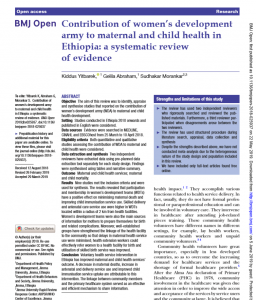
Objective
The aim of this review was to identify, appraise and synthesise studies that reported on the contribution of the Women’s Development Army (WDA) to maternal and child health development.
Setting
Studies conducted in Ethiopia 2010 onwards and published in English were considered.
Data sources
Evidence were searched in MEDLINE, CINAHL and EBSCOhost from 25 March to 10 April 2018.
Eligibility criteria
Both quantitative and qualitative studies assessing the contribution of the WDA to maternal and child health were considered.
Data extraction and synthesis
Two independent reviewers have extracted data using a pre-planned data extraction tool separately for each study design. Findings were synthesised using tables and narrative summary.
Outcome
Maternal and child health services; maternal and child mortality.
Results
Nine studies met the inclusion criteria and were used for synthesis. The results revealed that participation and membership in the Women’s Development Teams (WDTs) have a positive effect on minimising maternal death and improving child immunisation service use. Skilled delivery and antenatal care service use were higher in WDTs located within a radius of 2 km from health facilities. Women’s Development Teams were also the main sources of information for mothers to prepare for birth and related complications. Moreover, well-established groups have strengthened the linkage of the health facility to the community, so that delays in maternal health service use were minimised; health extension workers could effectively refer women to a health facility for birth and the utilisation of skilled birth service was improved.
Conclusion
Voluntary health service intervention in Ethiopia has improved maternal and child health services’ outcome. A decrease in maternal deaths, increase in antenatal and delivery service use and improved child immunisation service uptake are attributable to this intervention. The linkage between community members and the primary healthcare system served as an effective and efficient mechanism to share information.